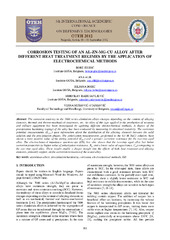Corrosion Testing of an Al-Zn-Mg-Cu Alloy After Different Heat Treatment Regimes by the Application of Electrochemical Methods
Конференцијски прилог (Објављена верзија)
Метаподаци
Приказ свих података о документуАпстракт
Abstract: The corrosion tendency in the 7000 series aluminium alloys changes depending on the content of alloying
elements, thermal and thermo-mechanical treatments, etc. An alloy of this type applied in the production of weapons
and military equipment has been investigated by applying different electrochemical methods. A degree of the
precipitation hardening (aging) of the alloy has been evaluated by measuring its electrical resistivity. The corrosion
potential measurements (Ecorr.) gave information about the distribution of the alloying elements between the solid
solution and the precipitation phases. The polarization measurements, performed in the 0.5 M NaCl solution, have
shown a more positive value of the pitting potential (Epit.) and a greater corrosion resistance for the two-step aged
alloy. The electrochemical impedance spectroscopy (EIS) has also shown that the two-step aged alloy has better
corrosion properties (a higher value of polarization resistance, Rp, and a low...er value of capacitance, Cdl) comparing to
the one-step aged alloy. These results enable a deeper insight into the effects of both heat treatment and alloying
elements, primarily copper, on the corrosion resistance of the tested alloy.
Кључне речи:
aluminium alloys / precipitation hardening / corrosion / electrochemical methods / EISИзвор:
5th International Scientific Conference on Defensive Technologies, 2012, 588-593Издавач:
- Military Technical Institute
Финансирање / пројекти:
- Истраживање и оптимизација технолошких и функционалних перформанси вентилационог млина термоелектране Костолац Б (RS-MESTD-Technological Development (TD or TR)-34028)
- Синтеза, развој технологија добијања и примена наноструктурних мултифункционалних материјала дефинисаних својстава (RS-MESTD-Integrated and Interdisciplinary Research (IIR or III)-45019)
Институција/група
Inovacioni centarTY - CONF AU - Jegdić, Bore AU - Alil, Ana AU - Bobić, Biljana AU - Radosavljević, Miroslav AU - Mišković-Stanković, Vesna PY - 2012 UR - http://TechnoRep.tmf.bg.ac.rs/handle/123456789/6092 AB - Abstract: The corrosion tendency in the 7000 series aluminium alloys changes depending on the content of alloying elements, thermal and thermo-mechanical treatments, etc. An alloy of this type applied in the production of weapons and military equipment has been investigated by applying different electrochemical methods. A degree of the precipitation hardening (aging) of the alloy has been evaluated by measuring its electrical resistivity. The corrosion potential measurements (Ecorr.) gave information about the distribution of the alloying elements between the solid solution and the precipitation phases. The polarization measurements, performed in the 0.5 M NaCl solution, have shown a more positive value of the pitting potential (Epit.) and a greater corrosion resistance for the two-step aged alloy. The electrochemical impedance spectroscopy (EIS) has also shown that the two-step aged alloy has better corrosion properties (a higher value of polarization resistance, Rp, and a lower value of capacitance, Cdl) comparing to the one-step aged alloy. These results enable a deeper insight into the effects of both heat treatment and alloying elements, primarily copper, on the corrosion resistance of the tested alloy. PB - Military Technical Institute C3 - 5th International Scientific Conference on Defensive Technologies T1 - Corrosion Testing of an Al-Zn-Mg-Cu Alloy After Different Heat Treatment Regimes by the Application of Electrochemical Methods EP - 593 SP - 588 UR - https://hdl.handle.net/21.15107/rcub_technorep_6092 ER -
@conference{
author = "Jegdić, Bore and Alil, Ana and Bobić, Biljana and Radosavljević, Miroslav and Mišković-Stanković, Vesna",
year = "2012",
abstract = "Abstract: The corrosion tendency in the 7000 series aluminium alloys changes depending on the content of alloying
elements, thermal and thermo-mechanical treatments, etc. An alloy of this type applied in the production of weapons
and military equipment has been investigated by applying different electrochemical methods. A degree of the
precipitation hardening (aging) of the alloy has been evaluated by measuring its electrical resistivity. The corrosion
potential measurements (Ecorr.) gave information about the distribution of the alloying elements between the solid
solution and the precipitation phases. The polarization measurements, performed in the 0.5 M NaCl solution, have
shown a more positive value of the pitting potential (Epit.) and a greater corrosion resistance for the two-step aged
alloy. The electrochemical impedance spectroscopy (EIS) has also shown that the two-step aged alloy has better
corrosion properties (a higher value of polarization resistance, Rp, and a lower value of capacitance, Cdl) comparing to
the one-step aged alloy. These results enable a deeper insight into the effects of both heat treatment and alloying
elements, primarily copper, on the corrosion resistance of the tested alloy.",
publisher = "Military Technical Institute",
journal = "5th International Scientific Conference on Defensive Technologies",
title = "Corrosion Testing of an Al-Zn-Mg-Cu Alloy After Different Heat Treatment Regimes by the Application of Electrochemical Methods",
pages = "593-588",
url = "https://hdl.handle.net/21.15107/rcub_technorep_6092"
}
Jegdić, B., Alil, A., Bobić, B., Radosavljević, M.,& Mišković-Stanković, V.. (2012). Corrosion Testing of an Al-Zn-Mg-Cu Alloy After Different Heat Treatment Regimes by the Application of Electrochemical Methods. in 5th International Scientific Conference on Defensive Technologies Military Technical Institute., 588-593. https://hdl.handle.net/21.15107/rcub_technorep_6092
Jegdić B, Alil A, Bobić B, Radosavljević M, Mišković-Stanković V. Corrosion Testing of an Al-Zn-Mg-Cu Alloy After Different Heat Treatment Regimes by the Application of Electrochemical Methods. in 5th International Scientific Conference on Defensive Technologies. 2012;:588-593. https://hdl.handle.net/21.15107/rcub_technorep_6092 .
Jegdić, Bore, Alil, Ana, Bobić, Biljana, Radosavljević, Miroslav, Mišković-Stanković, Vesna, "Corrosion Testing of an Al-Zn-Mg-Cu Alloy After Different Heat Treatment Regimes by the Application of Electrochemical Methods" in 5th International Scientific Conference on Defensive Technologies (2012):588-593, https://hdl.handle.net/21.15107/rcub_technorep_6092 .



